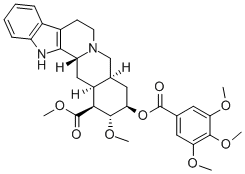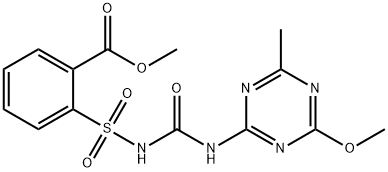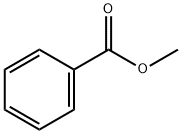Deserpidine
- CAS NO.:131-01-1
- Empirical Formula: C32H38N2O8
- Molecular Weight: 578.65
- MDL number: MFCD00078228
- EINECS: 205-004-8
- SAFETY DATA SHEET (SDS)
- Update Date: 2025-10-29 15:43:00

What is Deserpidine?
Toxicity
Symptoms of overdose include dizziness or drowsiness (severe), flushing of skin, pinpoint pupils of eyes and slowed pulse.
Chemical properties
Crystalline solid; exists in three crystallineforms; mp 228–232°C (442.4–449.6°F); soluble in chloroform and methanol, insolublein water; pK 6.68 in saturated solution of40% methanol in water.
Originator
Harmonyl,Abbott,US,1957
The Uses of Deserpidine
Deserpidine is found and extracted fromthe roots of Rauwolfia canescens L., andApocyanaceae. Therapeutically, it is used asan antihypertensive agent.
The Uses of Deserpidine
Deserpidine, is an antihypertensive drug related to Reserpine (R144600). It is naturally found in Rauvolfia spp.
What are the applications of Application
Deserpidine is a specialty product for proteomics research
Background
Deserpidine is an ester alkaloid drug isolated from Rauwolfia canescens (family Apocynaceae) with antipsychotic and antihypertensive properties that has been used for the control of high blood pressure and for the relief of psychotic behavior.
Indications
For the treatment of hypertension.
Definition
ChEBI: Deserpidine is an alkaloid ester, a methyl ester, a benzoate ester, an organic heteropentacyclic compound and a yohimban alkaloid. It derives from a hydride of a yohimban.
Manufacturing Process
500 parts by weight of dried, finely ground roots of Rauwolfia canescens are
extracted batchwise with methanol at its boiling point, using the following
volumes and times, and filtering each extract while hot: 2,000 parts by
volume, 1 hour; 1,000 parts by volume, 45 minutes; 1,000 parts by volume,
30 minutes; 1,000 parts by volume, 30 minutes. The extracts are combined
and evaporated in vacuo to 75 parts by volume of a thick syrupy solution.
After the addition of 75 parts by volume of methanol and 150 parts by volume
of acetic acid of 15% strength with adequate mixing, the solution is extracted
with 2 portions each of 100 parts by volume of hexane. The combined hexane extracts are extracted with 15 parts by volume of acetic acid of 15% strength.
The latter extract is added to the above acetic acid phase which is then
extracted with 3 portions each of 75 parts by volume and 1 portion of 50
parts by volume of ethylene chloride.
The first three extracts are combined and washed with 60 parts by volume of
2 N sodium carbonate solution and then with 60 parts by volume of distilled
water. These washing solutions are saved and used for the washing of the 4th
and final ethylene chloride extract. The combined ethylene chloride extracts
are dried over sodium sulfate, filtered and evaporated in vacuo to a constant
weight of a tan, frothy solid. One part by weight of this residue is dissolved in
1.5 parts by volume of warm methanol and the solution cooled to 5°C for 18
hours, whereby crystallization of a mixture containing principally reserpine
sets in. After filtering this mixture and washing it with cool methanol, the
filtrate is freed of solvent in vacuo.
Two parts by weight of the resulting red-brown solid froth are triturated with 2
portions each of 25 parts by volume of benzene and filtered each time. The
benzene insoluble material is saved for further treatment. The benzene soluble
fraction is poured on to a column of 40 parts by weight of activated alumina
(Woelm, Activity Grade I) which is then eluted first with 3 portions each of 50
parts by volume of benzene and then with 6 portions each of 50 parts by
volume of benzene-acetone (9:1), the first of which benzene-acetone portions
had been used for extraction of the abovementioned benzene insoluble
material. The second of the 6 benzene-acetone elution fractions on removal of
the solvents gives a light tan solid froth which on crystallization from
methanol gives colorless prismatic needles of slightly impure deserpidine.
Rechromatographing of 1 part by weight of this substance on 20 parts by
weight of activated alumina (Woelm, Activity Grade I) using benzene and
benzene containing 0.1% methanol as eluting agents followed by
crystallization from methanol gives colorless prismatic needles of pure
deserpidine, melting at 228-232°C. Deserpidine obtained according to this
example can be made up into pharmaceutical preparations.
brand name
Harmonyl(Abbott).
Therapeutic Function
Antihypertensive
Health Hazard
The pharmacological properties of deserpi dine are similar to those of reserpine, causingsedation and tranquilization. Toxic effectsfrom high doses include drowsiness, depres sion, nausea, diarrhea, abdominal cramps,and hypotension. It is less toxic than reserpine. However, the poisoning effects may begreater than those of other Rauwolfia alka loids, such as rescinnamine. An oral LD50value in mice is 500 mg/kg.There is some evidence of its carcinogenic actions in animals and humans. Ratsgiven oral doses of 54 mg/kg over 77 weeksdeveloped blood tumor. In humans, it mayproduce tumors in skin and appendages.Cancer-causing properties of deserpidine,however, are not yet fully established.
Pharmacokinetics
Deserpidine, an alkaloid of Rauwolfia canescens, is used as an antihypertensive. Rauwolfia alkaloids work by controlling nerve impulses along certain nerve pathways. As a result, they act on the heart and blood vessels to lower blood pressure.
Metabolism
Not Available
Properties of Deserpidine
| Melting point: | 228-232°; mp 230-232°; mp 138° and 226-232° with resolidification at 175° |
| Boiling point: | 638.28°C (rough estimate) |
| alpha | D20 -163° (c = 0.5 in pyridine) |
| Density | 1.2277 (rough estimate) |
| refractive index | 1.6260 (estimate) |
| storage temp. | -20°C Freezer |
| solubility | Chloroform (Slightly), Methanol (Slightly) |
| form | Solid |
| pka | 6.68 in 40% methanol |
| color | White to Off-White |
| CAS DataBase Reference | 131-01-1(CAS DataBase Reference) |
| NIST Chemistry Reference | Deserpidine(131-01-1) |
Safety information for Deserpidine
Computed Descriptors for Deserpidine
New Products
Indole Methyl Resin tert-butyl 9-methoxy-3-azaspiro[5.5]undecane-3-carboxylate Boc-His(Boc)-OH 2-CTC Resin 4-Chloro-7-tosy1-7Hpyrrolo[2,3-d]pyrimidine 5,7-Dibromo-1H-indole 2,5-dichloro-N-hydroxy-4,6-dimethylpyridine-3-carboximidamide 2,2-Dimethoxy-7-azaspiro[3.5]nonane hydrochloride 4-chloromethyl-5-methyl-1,3-dioxol-2-one (DMDO-Cl) R-2-BENZYLOXY PROPIONIC ACID 1,1’-CARBONYLDIIMIDAZOLE 1,1’-CARBONYLDI (1,2-4 TRIAZOLE) N-METHYL INDAZOLE-3-CARBOXYLIC ACID 4-((2-hydroxyethyl)thio)benzoic acid 1-(TERT-BUTOXYCARBONYL)-2-PYRROLIDINONE Methyl 6-methylnicotinate 3-Pyridineacrylic acid tert-Butyl carbazate TETRAHYDRO-2H-PYRAN-3-OL 2-((4-morpholinophenylamino) (methylthio) methylene) malononitrile 3-(4-morpholinophenylamino)-5-amino-1H-pyrazole-4-carbonitrile 2,4-dihydroxybenzaldehyde 1,3-Diethyl-1,3-Diphenylurea Methyl 2-methylquinoline-6-carboxylateRelated products of tetrahydrofuran








You may like
-
 Pyridine 99.5% HPLC /UV SpectroscopyView Details
Pyridine 99.5% HPLC /UV SpectroscopyView Details
110-86-1 -
 Guanine , 99%View Details
Guanine , 99%View Details
73-40-5 -
 Piperazine Spot supply, best priceView Details
Piperazine Spot supply, best priceView Details
110-85-0 -
 Potassium Hydroxide 90%View Details
Potassium Hydroxide 90%View Details
1310-58-3 -
 Dibutyl PhthalateView Details
Dibutyl PhthalateView Details
84-74-2 -
 Imidazole Spot supply, competitive priceView Details
Imidazole Spot supply, competitive priceView Details
288-32-4 -
 Octadecyl 3-(3,5-di-tert-butyl-4-hydroxyphenyl)propionate 98% (GC)View Details
Octadecyl 3-(3,5-di-tert-butyl-4-hydroxyphenyl)propionate 98% (GC)View Details
2082-79-3 -
 Thiourea 99% ARView Details
Thiourea 99% ARView Details
62-56-6
